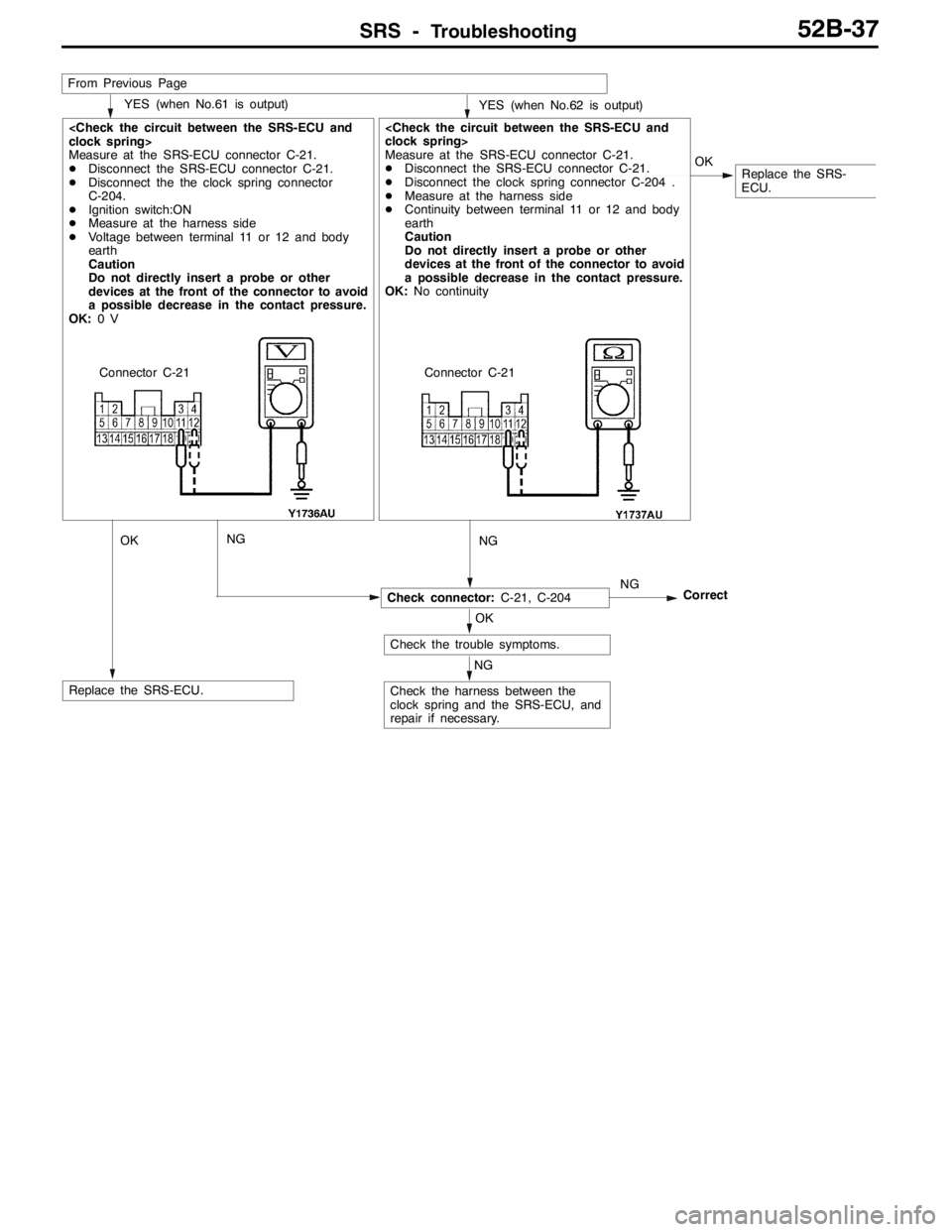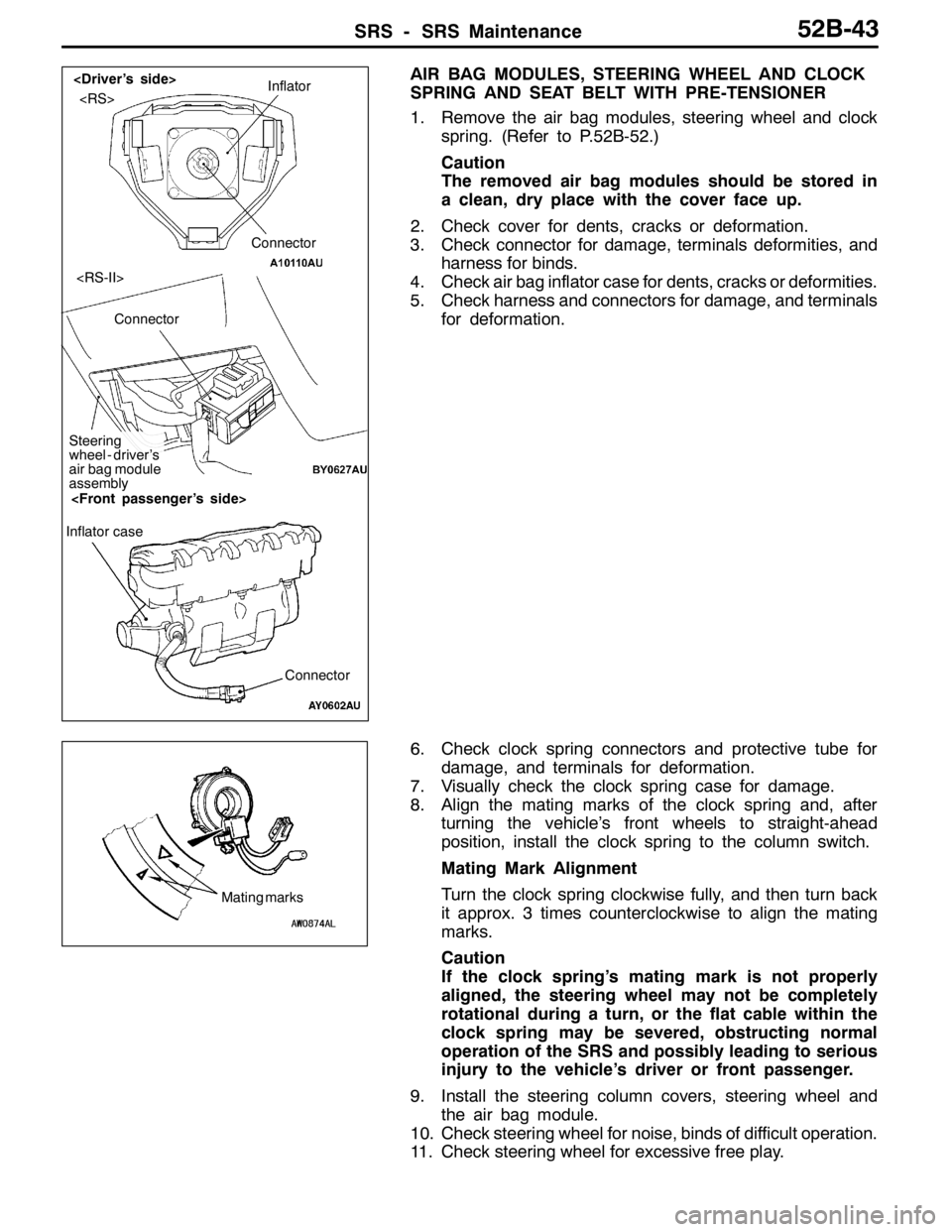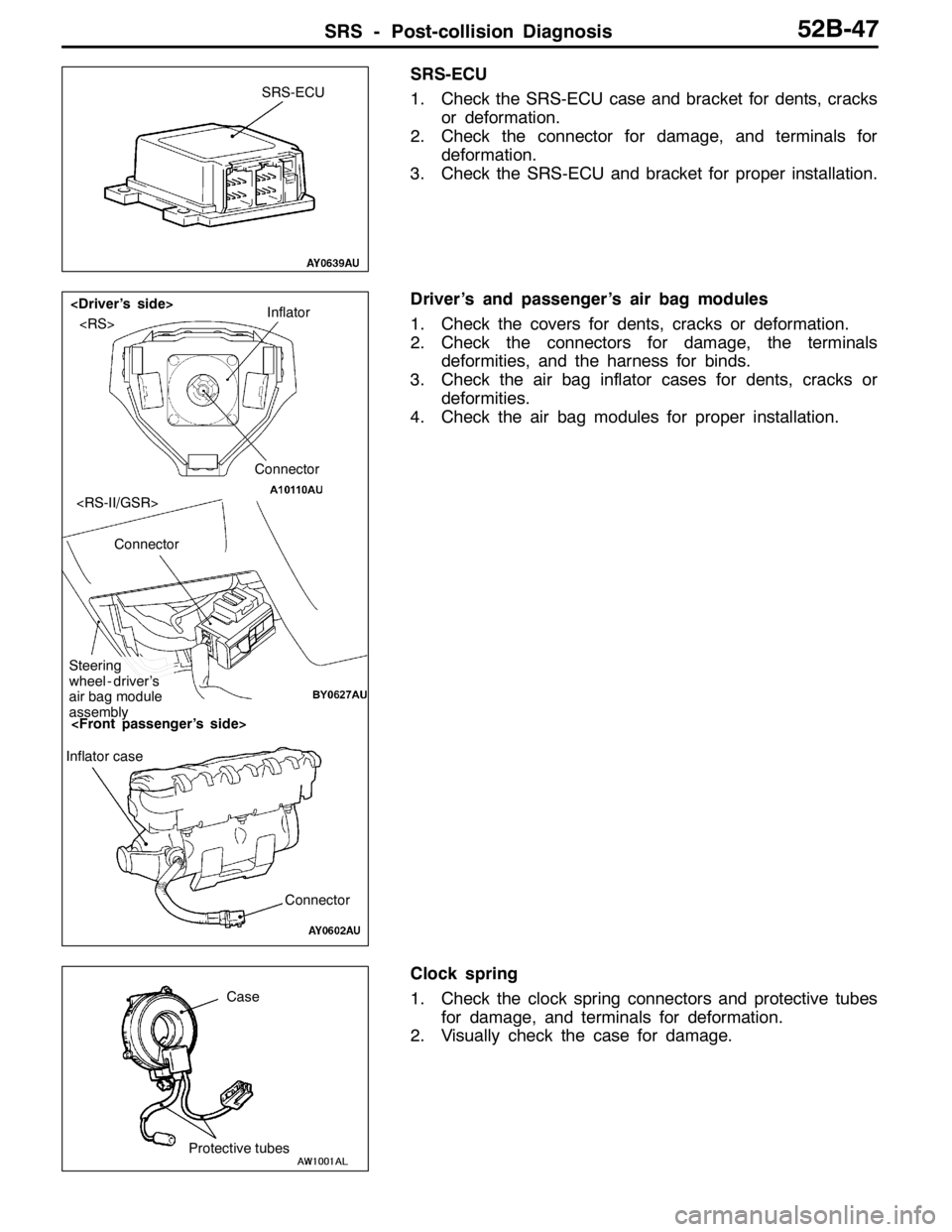lock MITSUBISHI LANCER EVOLUTION 2007 Service Repair Manual
[x] Cancel search | Manufacturer: MITSUBISHI, Model Year: 2007, Model line: LANCER EVOLUTION, Model: MITSUBISHI LANCER EVOLUTION 2007Pages: 1449, PDF Size: 56.82 MB
Page 1281 of 1449

SRS -Troubleshooting52B-37
Replace the SRS-ECU.
Measure at the SRS-ECU connector C-21.
DDisconnect the SRS-ECU connector C-21.
DDisconnect the the clock spring connector
C-204.
DIgnition switch:ON
DMeasure at the harness side
DVoltage between terminal 11 or 12 and body
earth
Caution
Do not directly insert a probe or other
devices at the front of the connector to avoid
a possible decrease in the contact pressure.
OK:0V
NG
From Previous Page
YES (when No.62 is output)YES (when No.61 is output)
Replace the SRS-
ECU.
Correct
Check connector:C-21, C-204
Check the trouble symptoms.
Check the harness between the
clock spring and the SRS-ECU, and
repair if necessary.OK
Measure at the SRS-ECU connector C-21.
DDisconnect the SRS-ECU connector C-21.
DDisconnect the clock spring connector C-204 .
DMeasure at the harness side
DContinuity between terminal 11 or 12 and body
earth
Caution
Do not directly insert a probe or other
devices at the front of the connector to avoid
a possible decrease in the contact pressure.
OK:No continuity
NG
OK
NG
OK
NG
Connector C-21 Connector C-21
Page 1286 of 1449

SRS - SRS Maintenance52B-42
SRS MAINTENANCE
The SRS must be inspected by an authorized dealer 10 years
after the date of vehicle registration.
SRS WARNING LAMP CHECK
Turn the ignition switch to the ON position. Does the SRS
warning lamp illuminate for about 7 seconds, and then go
out? If yes, SRS system is functioning properly. If no, refer
to page 52B-6.
SRS COMPONENT VISUAL CHECK
Turn the ignition key to LOCK (OFF) position, disconnect
the negative ( - ) battery cable and tape the terminal.
Caution
Wait at least 60 seconds after disconnecting the battery
cable before doing any further work. (Refer to P.52B-3.)
SRS CONTROL UNIT (SRS-ECU)
1. Check SRS-ECU case and brackets for dents, cracks,
deformation or rust.
Caution
The SRS may not activate if the SRS-ECU is not
installed properly, which could result in serious injury
or death to the vehicle’s driver or front passenger.
2. Check connector for damage, and terminals for
deformation or rust.
Replace SRS-ECU if it fails visual check.
(Refer to P.52B-50.)
SRS warning lamp
Insulating tape
Battery
Battery
( - ) cable
SRS-ECU
Page 1287 of 1449

SRS - SRS Maintenance52B-43
AIR BAG MODULES, STEERING WHEEL AND CLOCK
SPRING AND SEAT BELT WITH PRE-TENSIONER
1. Remove the air bag modules, steering wheel and clock
spring. (Refer to P.52B-52.)
Caution
The removed air bag modules should be stored in
a clean, dry place with the cover face up.
2. Check cover for dents, cracks or deformation.
3. Check connector for damage, terminals deformities, and
harness for binds.
4. Check air bag inflator case for dents, cracks or deformities.
5. Check harness and connectors for damage, and terminals
for deformation.
6. Check clock spring connectors and protective tube for
damage, and terminals for deformation.
7. Visually check the clock spring case for damage.
8. Align the mating marks of the clock spring and, after
turning the vehicle’s front wheels to straight-ahead
position, install the clock spring to the column switch.
Mating Mark Alignment
Turn the clock spring clockwise fully, and then turn back
it approx. 3 times counterclockwise to align the mating
marks.
Caution
If the clock spring’s mating mark is not properly
aligned, the steering wheel may not be completely
rotational during a turn, or the flat cable within the
clock spring may be severed, obstructing normal
operation of the SRS and possibly leading to serious
injury to the vehicle’s driver or front passenger.
9. Install the steering column covers, steering wheel and
the air bag module.
10. Check steering wheel for noise, binds of difficult operation.
11. Check steering wheel for excessive free play.Inflator
Connector
Connector
Steering
wheel - driver’s
air bag module
assembly
Connector Inflator case
Mating marks
Page 1289 of 1449

SRS - Post-collision Diagnosis52B-45
POST-COLLISION DIAGNOSIS
Whether or not the air bags have deployed, check and service
the vehicle after collision as follows:
SRS-ECU MEMORY CHECK
1. Connect the MUT-IIto the diagnosis connector. (Refer
to GROUP 00 – How to Use Troubleshooting/Inspection
Service Points.)
Caution
Refer to that the ignition switch is LOCK(OFF) when
connecting or disconnecting MUT-II.
2. Read (and write down) all displayed diagnosis codes.
(Refer to P.52B-9.)
NOTE
If battery power supply has been shut down by the
collision, the MUT-IIcannot communicate with the
SRS-ECU. Check and, repair if necessary, the instrument
panel wiring harness before the next job.
3. Use the the MUT-IIto read the data list (how long trouble(s)
have continued and how often memory have been
erased).
Data list
NoService Data ItemApplicability
92Number indication how often the memory is cleared.Maximum time to be stored: 250
93How long problem have lasted (How long it takes
from the occurrence of the problem till the first air bag
squib igniting signal)Maximum time to be stored: 9999 minutes
(approximately 7 days)
94How long problem(s) have lasted (How long it takes
from the first air bag squib igniting signal till now.)
4. Erase the diagnosis codes and after waiting 5 seconds
or more read (and write down) all displayed diagnosis
codes. (Refer to P.52B-9.)
Page 1290 of 1449

SRS - Post-collision Diagnosis52B-46
REPAIR PROCEDURE
DEPLOYED DRIVER’S AND FRONT PASSENGER’S AIR
BAGS OR OPERATED SEAT BELT PRE-TENSIONER.
1. Replace the following parts with new ones.
DSRS-ECU (Refer to P.52B-50.)
DDriver’s air bag module (Refer to P.52B-52.)
DFront passenger’s air bag module (Refer to P.52B-52.)
DSeat belt with pre-tensioner (Refer to P.52B-61.)
2. Check the following parts and replace if malfunction is
found:
DClock spring (Refer to P.52B-52.)
DSteering wheel, steering column and intermediate
joint
(1) Check the wiring harness (built into steering
wheel) and connectors for damage, and terminals
for deformation.
(2) Check the driver’s air bag module for proper
installation to the steering wheel.
(3) Check the steering wheel for noise, binds or
difficult operation and excessive free play.
3. Check the harness for binding, connectors for damage,
poor connections, and terminals for deformation.
(Refer to P.52B-44.)
UNDEPLOYED AIR BAGS OR UNOPERATED SEAT BELT
WITH PRE-TENSIONER IN LOW-SPEED COLLISION
Check the SRS components and seat belt with pre-tensioner.
If visible damage such as dents, cracks, or deformation are
found on the SRS components and seat belt with
pre-tensioner, replace them with new ones. Concerning parts
removed for inspection, replacement with new parts and
cautions in working, refer to INDIVIDUAL COMPONENT
SERVICE, P.52B-49.
Page 1291 of 1449

SRS - Post-collision Diagnosis52B-47
SRS-ECU
1. Check the SRS-ECU case and bracket for dents, cracks
or deformation.
2. Check the connector for damage, and terminals for
deformation.
3. Check the SRS-ECU and bracket for proper installation.
Driver’s and passenger’s air bag modules
1. Check the covers for dents, cracks or deformation.
2. Check the connectors for damage, the terminals
deformities, and the harness for binds.
3. Check the air bag inflator cases for dents, cracks or
deformities.
4. Check the air bag modules for proper installation.
Clock spring
1. Check the clock spring connectors and protective tubes
for damage, and terminals for deformation.
2. Visually check the case for damage.
SRS-ECU
Inflator
Connector
Connector
Steering
wheel - driver’s
air bag module
assembly
Connector Inflator case
Protective tubesCase
Page 1293 of 1449

SRS - Individual Component Service/Warning/Caution Labels52B-49
INDIVIDUAL COMPONENT SERVICE
If the SRS components and seat belt with pre-tensioner are to be removed or replaced as a result of
maintenance, troubleshooting etc., follow the service procedures that follow.
Caution
1. SRS components and seat belt with pre-tensioner should not be subjected to heat, so remove
the SRS-ECU, driver’s air bag module
passenger’s air bag module, clock spring, and seat belt with pre-tensioner before drying or
baking the vehicle after painting.
DFront impact sensor, SRS-ECU, Air bag module, clock spring: 93_C or more
DSeat belt with pre-tensioner: 90_C or more
Recheck SRS system operability after re-installing them.
2. If the SRS components and seat belt with pre-tensioner are removed for the purpose of check,
sheet metal repair, painting, etc., they should be stored in a clean, dry place until they are
reinstalled.
WARNING/CAUTION LABELS
Caution labels on the SRS are attached in the
vehicle as shown. Follow label instructions whenservicing the SRS. If the label(s) are dirty or
damaged, replace with new one(s).
Steering wheel
Driver’s air bag module
Clock springFront passenger’s
air bag moduleSRS-ECU
Sun visor
Steering joint cover
Glove boxCover
Seat belt with pre-tensioner
Page 1294 of 1449

SRS - SRS-ECU52B-50
SRS AIR BAG CONTROL UNIT (SRS-ECU)
Caution
1. Disconnect the negative ( - ) battery terminal
and wait for 60 seconds or more before
starting work. Also, the disconnected
battery terminal should be insulated with
tape. (Refer to P.52B-3.)
2. Never attempt to disassemble or repair the
SRS-ECU. If faulty, just replace with a new
one.3. Do not drop or subject the SRS-ECU to
impact or vibration.
If denting, cracking, deformation, or rust are
found in the SRS-ECU, replace it with a new
one. Discard the old one.
4. After deployment of the air bags, replace
the SRS-ECU with a new one.
5. Never use an ohmmeter on or near the
SRS-ECU, and use only the special test
equipment described on P.52B-6.
REMOVAL AND INSTALLATION
Pre-removal Operation
DTurn Ignition Key to LOCK (OFF) Position.
DDisconnect the Negative ( - ) Battery Terminal.
12
4.9±1.0 N·m
4.9±1.0 N·m
4.9±1.0 N·m
3
Removal steps
DFront floor console
(Refer to GROUP 52A - Front floor
console.)
DRear heater duct B
1. SRS-ECU and SRS-ECU bracket
assembly
2. SRS-ECU
3. SRS-ECU bracketInstallation steps
3. SRS-ECU bracket
"AA2. SRS-ECU
1. SRS-ECU and SRS-ECU bracket
assembly
DRear heater duct B
DFront floor console
(Refer to GROUP 52A - Front floor
console.)
DNegative ( - ) battery terminal
connection
"BADPost-installation inspection
Page 1296 of 1449

SRS - Air Bag Modules and Clock Spring52B-52
AIR BAG MODULES AND CLOCK SPRING
Caution
1. Disconnect the negative ( - ) battery terminal
and wait for 60 seconds or more before
starting work. Also, the disconnected
battery terminal should be insulated with
tape. (Refer to P.52B-3.)
2. Never attempt to disassemble or repair the
air bag modules and clock spring.
If faulty, just replace with new one(s).
3. Do not drop the air bag modules or clock
spring or allow contact with water, grease
or oil.
Replace if a dent, crack, deformation or rust
are present.
4. Store the air bag modules on a flat surface
with the deployment surface facing up.
Do not place anything on top of them.5. Do not store the air bag modules in a place
more than 93_C.
6. When the driver’s and front passenger’s air
bags have been deployed, replace the
driver’s and passenger’s air bag modules
with new ones.
7. Put on gloves and safety glasses when
handling deployed air bags.
8. When discarding the undeployed air bag
module(s), be sure to deploy the air bag(s)
in advance as specified in the service
procedure. (Refer to to P.52B-64.)
Page 1297 of 1449

SRS - Air Bag Modules and Clock Spring52B-53
REMOVAL AND INSTALLATION
Pre-removal Operation
Disconnect the Negative ( - ) Battery Terminal.
3 2
41
0.9±0.2 N·m
0.9±0.2 N·m41±8 N·m
Driver’s air bag module removal
steps
AA"1. Driver’s air bag moduleDriver’s air bag module installation
steps
"AADPre-installation inspection
1. Driver’s air bag module
DNegative ( - ) terminal of the battery
connection
"DADPost-installation inspection
Clock spring removal steps
AA"1. Driver’s air bag module
AB"2. Steering wheel
3. Lower column cover
AC"4. Clock springClock spring installation steps
"AADPre-installation inspection
"BA4. Clock spring
3. Lower Column Cover
"CA2. Steering wheel
1. Driver’s air bag module
DNegative ( - ) terminal of the battery
connection
"DADPost-installation inspection